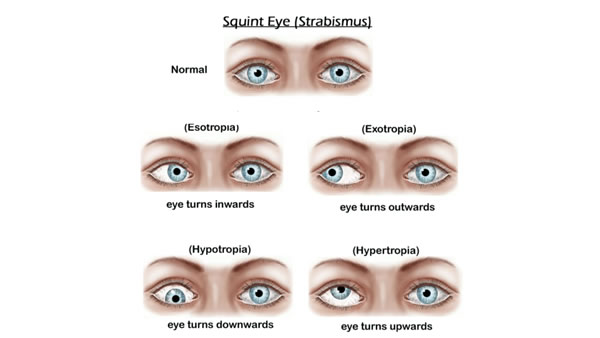
Strabismus, also known as crossed or turned eye, is the medical term used when the two eyes are not straight. It occurs in appr- oximately 2 to 4 percent of the population.
Symptoms of Squint
- Turned or crossed eye.
- Squinting.
- Head tilting or turning.
- Double vision (in some cases).
Types of Squint
- Convergent Squint or Esotropia
- Divergent Squint or Exotropia
- Vertical Strabismus
- Paralytic Strabismus
- Restrictive Strabismus
Convergent Squint or Esotropia
Convergent Squint or Esotropia is a type of squint in which one or both eyes turn inward towards the nose. It can be constant or intermittent and may occur in one eye or alternate between the two eyes. Causes include muscle imbalance, refractive errors, or neurological conditions.
Divergent Squint or Exotropia
Divergent Squint or Exotropia is a type of squint in which one or both eyes turn outward away from the nose. It is often more noticeable when tired or focusing on distant objects. Causes include muscle imbalance, refractive errors, or neurological conditions.
Vertical Strabismus
Vertical Strabismus refers to the misalignment of the visual axes in the vertical direction, causing one eye to be higher than the other. It can occur as an isolated condition or alongside horizontal strabismus.
Paralytic Strabismus
Paralytic Strabismus occurs due to damage to the third, fourth, or sixth cranial nerves, often resulting from poor blood supply, nerve pressure, or head injuries. It causes limited eye movements and misalignment.
Restrictive Strabismus
Restrictive Strabismus involves a "mechanical" restriction that limits the eye's movement in a specific direction. While rare in children, it is more commonly acquired in adulthood due to trauma or disease.
Treatment
The aim of treatment is to restore good vision to each eye and good binocular vision. Treatment usually includes patching the eye that is always straight to bring the vision up to normal in the turned eye. Glasses may be used, particularly for eyes that are out of focus. Glasses and special drops (phospholine iodide) may also help straighten the eyes. Surgery on the eye muscles is sometimes necessary.






